 |
 |
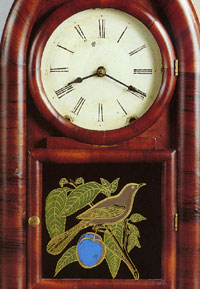
BURY CLOCKMAKERS OF C19 |
By the 19th century many clocks were now factory made. Local clock sellers would buy in the movements, and perhaps add their trade names to the clock face, and fit them into cases of different qualities. Some of the earliest clock sellers of this century may still have made clocks themselves, but as the century passed on this practice died out.
The arrival of mass produced clocks from America finally ended British clock production. There were many American clock factories concentrated in Connecticut, which began to export their production after 1842. They had begun in 1807 in Bristol, Connecticut, when the Napoleonic Wars had interrupted the flow of goods from Britain. Gradually they concentrated on shelf clocks, as Long Cases were extremely difficult to ship across the great distances to the American West. By the 1850's the numerous small clockmakers of America had consolidated into seven giant companies whose productions would replace the British clock making industry entirely.
By about 1870 clocks were no longer being made in local workshops in Britain.
Directories list many names of Clock and Watch makers, and Haggar and Miller include them all. However, in cases where no items survive with these names, or this is the only evidence, they will not be included here below.
All of the Watch and Clockmakers on this page are listed alphabetically on the left, but are described below roughly in date order. Thus the earliest makers will thus appear first.
Click here if you wish to look back to The local 18th Century Makers |
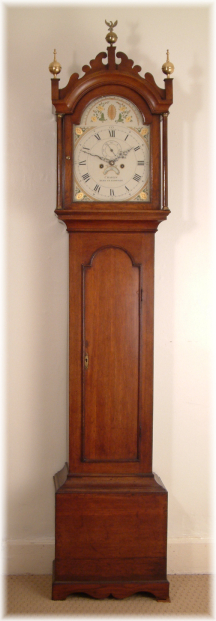 |
Thomas Chaplin 1799-1820 The Chaplin brothers, William & Thomas, are recorded as coming from London to work in Bury St Edmunds in partnership between 1776 and 1799, setting up as clockmakers, jewellers and silversmiths. They opened another shop in Lavenham in 1777 and branched out into groceries. Their 18th century clocks are recorded on the previous page. When William died in 1799, Thomas continued the business, possibly until his death aged 81 in 1827, having taken Thomas Fuller as a partner circa 1815. It is possible that Thomas retired in 1815 allowing Thomas Fuller to continue the business as Chaplin and Fuller. The shop was in Cook Row, in Bury St Edmunds, which is now known as Abbeygate Street, the name having changed in 1792. The first clock shown here is from the stock of clock dealer Leigh Extence.
William Chaplin died in 1799 and was buried in Acton, and Thomas died in 1827. Both brothers were buried in Acton, near Sudbury.
Chaplin and Fuller 1815-1827 Thomas Chaplin took Thomas Fuller into partnership at his Abbeygate Street premises in about 1815. The business now traded as Chaplin and Fuller, but it is possible that Chaplin had decided to retire and let Fuller run the business from this time. Thomas Chaplin died in 1827, ending the Chaplin name as one of the best known Bury Clockmakers. There is a painted longcase clock bearing the partnership name.
Joseph Leonard of Haverhill, 1819 The Ipswich Museum owns a watch made by Joseph Leonard of Haverhill. It is a verge watch movement, signed, "Joseph Leonard, Haverhill, No 5395", and dated "AD 1819". Haggar and Miller noted the unusual way in which the "A" and "D" were joined.
Thomas Fuller, Bury St Edmunds, 1823-1846 Thomas Fuller is recorded as a Watch and Clock maker in Guildhall Street in the 1823 Directory. Later Directories of 1830, 1839, 1844, and 1846 have his address as being 3 Churchgate Street. This may have been the same Fuller who was, probably from 1815, a partner with Thomas Chaplin.
W Clark, Bury St Edmunds, c1810 W Clark of Bury is represented in the Gershom Parkington collection by an uncased watch movement, with Roman numerals, dated to c.1810. It is signed 'W Clark, Bury, No 35377'.
James Hawkins, Bury St Edmunds, c1810 This maker is known from an advertisement in the Ipswich Journal, concerning a lost silver watch, with "the maker's name, James Hawkins, Bury St Edmunds, No 400."
James Hawke, Bury St Edmunds, early C19 Hawke is known from an oak 8 day painted dial Long Case clock, signed "Jas Hawke, Bury St Edmunds". The name Osborne is stamped on the false plate behind the dial. |
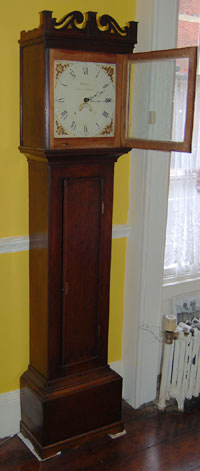 |
John Pace, Bury St Edmunds, 1823-1855 One man from the list of 19th century clockmakers in Bury towers above the rest. He was John Pace, a man who could make watches and the most exquisite clocks. He seems to have delighted in making small skeleton clocks, designed so that the mechanism was an ornament and showpiece of itself. John Pace had his shop in Abbeygate Street from 1823 until 1855. In later years the shop was recorded in the Directories at number 19 in that street, and may well have been there from the beginning. Pace was a leading figure in the Society of Friends, and was Secretary of the local Quaker Meetings from 1827 to 1832. John Pace worked in Bury St Edmunds making all types of clocks and watches, and had a good reputation for his skeleton clocks. He also patented a night time piece in 1833, which was number 6506. He could also produce barometers and was clearly willing to try all sorts of precision work in his workshop. The Long Case clock shown here is one of his bread and butter clocks, signed, "Jn. Pace, Bury St. Edmunds.", on a painted dial. It has a 30 hour movement, and still keeps good time in a private house in Bury St Edmunds. The dial is shown below:
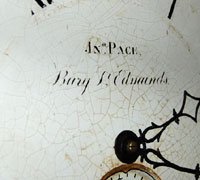 John Pace Longcase Dial One of his more expensive clocks was sold at Sotheby's in 1978, described as a Long Case Regulator. It was further described as a small George III mahogany regulator with a circular white painted dial, signed 'John Pace, Bury.' It had a wooden pendulum rod and stood 6 feet 11 inches tall.
|
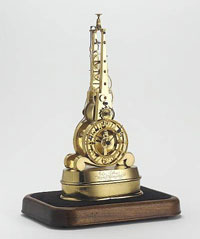 |
On 14 June 2005, one of Pace's brass skeleton clocks was sold at auction as lot 44 by Bonham's of New Bond Street for £4,800 including premiums.
Bonham's description was as follows: "A very rare second half of the 19th century brass skeleton timepiece of two week duration John Pace, Bury St Edmunds, 273 the frame cast of 6mm thick plates with chamfered edges formed as a circle on a pair of scroll supports with central vertical tapering support, the skeletonised arabic chapter ring with milled edges and dotted minute marks set in front of an open circular front plate with chamfered inner edge to a solid circular backplate united by two turned pillars, the going barrel movement configured so as to rise up the central section in a straight line, with five spoke crossings of extreme delicacy terminating in a deadbeat escapement, the pendulum with 'axe-headed' bob and steel rod with rise and fall regulation via a screw above, to the rear of the backplate a series of three pulleys united by very small fusee chain combine to drive the hands, the whole mounted on a signed and numbered chamfered oval base with additional base below on an associated mahogany plinth under a glass dome. 36cms. (14ins.) high" It was signed 'John Pace, Bury St Edmunds, 273', and this example had a two week duration movement.
|
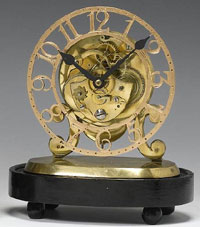 |
A less elaborate clock by Pace sold for £540 at Bonham's sale in September 2005. This was not numbered but was mounted on a signed oval base with shaped edge on a further plinth base, together with a later perspex protective cover 23cms. (9ins.) high. In 1851 John Pace exhibited at the Great Exhibition held at Crystal Palace in 1851. Page 419 of the Exhibition Catalogue refers to "Pace, J. Bury St Edmunds, - Inventor, Designer and Manufacturer". He showed two clocks and a barometer, as follows:
Pigot's Directory of Suffolk for 1839 listed John Pace of 19 Abbeygate Street under its category of Watch and Clockmakers. Pace was in the same trade and at the same address in White's Directory of 1844.
|
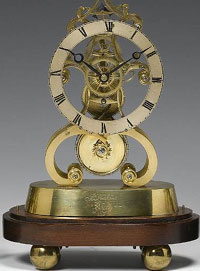 |
Benjamin Parker b1795 - 1855 Benjamin Parker's family came from Burgate and had property at Wortham. Benjamin was born on 10th October, 1795, but not baptised until 7th May, 1796 at St Mary's, in Bury St Edmunds. Benjamin Parker was a gunsmith, and was recorded as such in the directories for 1839, 1844 and 1855. His shop was at 30 Churchgate Street in 1839. There are a pair of Parker's pistols on display in Moyse's Hall Museum. Haggar and Miller did not notice him in their 1974 publication, but the 1979 Supplement records two 400 day skeleton clocks in his name, both illustrated in Royer-Collard's book.
An example of a Parker clock was sold by Bonhams in September 2005, and is illustrated here. It was listed as If Parker had produced 132 of these clocks, then many are missing from knowledge. Perhaps his numbering system covered both guns and clocks. |
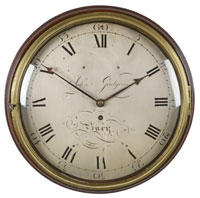 |
John Gudgeon, Bury 1785-1835 Clock dealers Carter Wright have a showroom in Nailsworth, Stroud, Gloucestershire. From 6 to 20 October 2007 they showed an exhibition of the renowned Richard Amos Collection of wall clocks. The collection comprised 30 clocks ranging in date from the 18th to the 20th centuries which were offered for sale at prices from £800 to £35,000. Every kitchen used to have its handsome clock on the wall and the Amos collection boasted several fine examples of wall clocks that would enhance any home today. Among them were three mahogany dial clocks dating from the reign of George III. One of these clocks was by John Gudgeon of Butter Market, Bury St Edmunds, circa 1805, with a silent escapement and priced at £5,500, The other two comprised one by Jabez Smith, London, circa 1790 , and one by Samuel Hunter, London, circa 1790. The clocks of these London makers were on sale for the same price, or less than, that of Gudgeon. John Gudgeon married Mary Lumley in 1785, and went into partnership with her widowed mother, also called Mary Lumley. Her late husband had been George Lumley, who was a watch and clock maker in Bury. John Gudgeon therefore most likely took over Lumley's premises in 14 Abbeygate Street at this time, and therefore spans the 18th and 19th centuries. In 1800, when Mary Lumley died, John Gudgeon continued at the shop at 14 Abbeygate Street. He seems to have let his son George take over at Abbeygate Street in 1815. In Directories for 1823 and 1830 John Gudgeon is now recorded as a Watch and Clock maker in the Buttermarket. He died in 1835, leaving his son George to take over any business interests that he still held. John Gudgeon also made watches. John Gudgeon of Bury left a watch in a double silver case, numbered 567, from 1805, now in the Gershom Parkington Collection. Also a watch in a double case with a tortoiseshell outer case. It has a verge escapement from c1794, and the maker's number of 27. John Gudgeon's work both pre-dates and overlaps with his son George Gudgeon listed below.
|
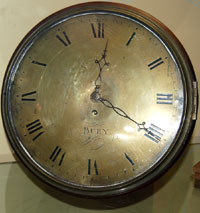 |
George Gudgeon, Bury, 1815-1839 The Gershom Parkington Catalogue listed a 48 hour Wall Clock by George Gudgeon, from about 1820, signed "Gudgeon junior". A brass dial exists from a turret clock signed "Gudgeon jnr". This turret clock was said to be from the site of County Hall Ipswich, when it was still a gaol. The clock shown here is on display in Moyses Hall Museum since 2007, and is signed simply "Gudgeon Bury." George Gudgeon probably worked with his father, John Gudgeon from at least 1800, at his father's shop at 14, Abbeygate Street. It seems that in about 1815 he was allowed to put the business into his own name. His father John appears to have carried on his trade in some capacity, possibly semi-retirement, in the Buttermarket. Directories for 1823, 1830, and Pigot's Directory for 1839 all list George Gudgeon at 14 Abbeygate Street, an address which is still used today for the sale of clocks and watches by jewellers Thurlow Champness. By the time of White's 1844 Directory, these premises were occupied by John Vale, (see below) for the same trade of Watch and Clockmakers.
|
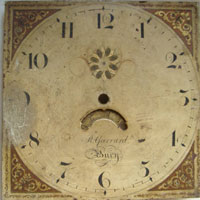 |
Robert Garrard, Bury, 1823-1846 Garrard is known from an oak long case clock, with a square painted dial. The dial illustrated here is signed "R. Garrard, Bury", and was sold on Ebay in October 2007. There was no mechanism attached. He was recorded in the Directories from 1823 to 1846 located in Guildhall Street. In 1830 he was located at number 37, but by 1846, he was at number 55. In the 1855 Directory a Robert Green Garrard was a Watch and Clock maker at 63 Guildhall Street. In the 1864 Directory there was a George Garrard at 55 Guildhall Street. A Jacob Garrard was selling clocks at Long Melford in 1855, and a James Garrard at Woolpit from 1844 to 1855.
|
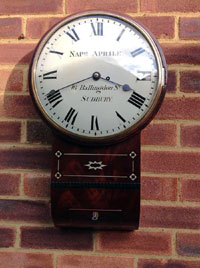 |
Napoleon Aprile, Sudbury, 1839-1864 Here we can see an early 19th century convex drop dial fusee wall clock by Napoleon Aprile, 16, Ballingdon street, Sudbury, Suffolk. It has a Mahogany case, the back box with brass inlay, radiused to the wall with locking bottom door and pendulum side access door. The 12" original white painted convex dial and blued steel hands are protected by a cast brass original convex glazed bezel. The line fusee movement has shaped shouldered plates separated by knopped pillars. Dimensions are 12" diameter dial 24" height, and the date is Circa 1840. It was for sale fully restored and guaranteed for the price of £2500.00, or €3397.75 or $3708.25 in January 2016 at Cove Clocks of Farnham in Surrey. MARRIAGES. Aprile- Graves.- Feb. 4th, at St. Gregory's Church, Sudbury, by the Rev. T. L. Green, Rector, Napoleon Aprile, of Ballingdon, to Martha Jane, eldest daughter of the late Mr. Graves, of Bury St. Edmund's. Barnes- Walker. - Feb. Napoleon and Joseph Aprile were brothers. Joseph seems to be the elder. They are recorded as watch and clockmakers and jewellers in Directories for 1839 and 1855, and also as Silversmiths and tobacconists in 1864 at Ballingdon. Haggar and Miller noted that Long Case clocks and barometers were known to survive with their names.
The following announcement was published in The Gazette:-
|
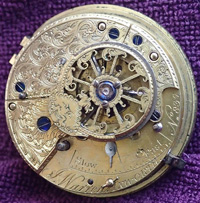 |
Joseph Warren, Ixworth, 1823-1855 Joseph Warren was recorded in the Directories for 1823, 1830, 1839, 1844 and 1855. His shop was in the High Street, Ixworth and there is a good article about him on the Ixworth village website here: The village website states that: "Joseph was actually born in Attleborough in Norfolk in the year of 1792 and passed away, at the elevated age of 84, in 1876. By his own admission, he came to Ixworth in 1818, so a very simple calculation yields that he was 26 years of age when he upped sticks and arrived in the village." Baillie records a watch by him. Also recorded was a 30 hour Long Case clock, in an oak case, with a painted dial.
The first watch movement shown here is numbered 837, and was recently sold by Allan Mitchell, who also took this excellent photograph. Details were supplied by the owner, Mr John Hutton, who kindly contacted me in 2018. It is a high quality verge movement and Mr Hutton suggests that its date must be somewhere between 1818 and the mid 1830s. |
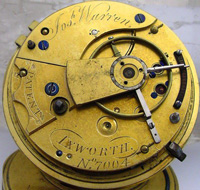 |
The second Warren watch is a picture taken from an auction sale on Worthpoint. The auction entry said it was dated around 1835, with a number in the 7000s, after Warren shifted from verge to lever movements. It is obviously of less fine workmanship than the first watch, which might suggest it is a bought-in factory made piece, to which Warren added his name. Joseph Warren also dealt in old coins and antiquities. He kept good notes of those items which passed through his hands, and it was Warren who recognised, and published his account of, the Anglo-Saxon pendant known as the Ixworth Cross in 1856.
The village website also recorded that:
By the time of White's Directory for 1874, Nathaniel Randell had taken over Warren's clock and watch business.
|
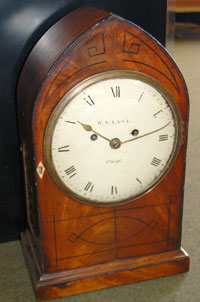 |
William Nelson Last, Bury, 1830-1864 Pigot's Directory of Suffolk for 1839 lists a William Nelson Last of 3 Abbeygate Street, under its category of Watch and Clockmakers. By 1844 White's Directory listed him under Watch and Clock makers as Wm Last (& chronometer). Last clearly thought himself a cut above ordinary clockmakers, and by 1844 he had moved to 10 Butter Market. Last seems to have been forever on the move. In the Directory for 1846, he was located at the Corn Exchange. By 1855 he was to be found at 15 Whiting Street, and by 1864 he was located at 44 St Andrews Street. He seems to have been a very good engraver, and his signature has been found on a Sundial which was sold by John Pace. |
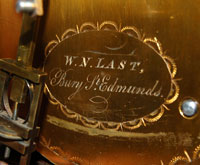 |
Modern day jeweller's Ernest Webb, established at 4 Risbygate Street in 1952, owns a bracket clock marked W N Last, Bury St Edmunds, dated to the early 19th century. It has a perpendicular arch, and the back plate is round rather than the more usual square. The face is signed "W. N. Last. Bury", but it cannot be said that the painting is of a high quality. The backplate is also signed, "W. N. Last Bury St Edmunds", but this is engraved, and is much better looking than the face. The 8 day movement had an unusually large mainspring which had snapped, and was replaced by Peter Webb. (NB The 1855 Directory listed a William B Last as a Watch and Clock maker at 41 Abbeygate Street.)
|
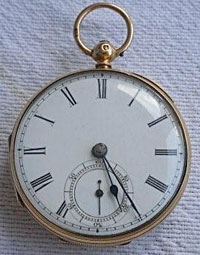 |
John Vale, Bury St Edmunds, 1839-1864 John Vale of Bury St Edmunds was a nineteenth century clockmaker. John Vale was not listed in Pigot's Directory of 1839, although Haggar and Miller say that he was. Number 14 Abbeygate Street was still in the hands of George Gudgeon at this time according to Pigot. Nevertheless it is generally accepted that John Vale took over at this address in 1839. However, in White's 1844 Directory, John Vale is now recorded at this address, and has definitely taken over the premises of George Gudgeon at 14 Abbeygate Street, Bury St Edmunds. The gold pocket watch seen here was offered for sale on EBay in May, 2011. Click on the thumbnail picture to see the back opened with Vale's signature. The Gershom Parkington Catalogue listed a drop dial 8 day Wall Clock under his name from about 1855. The collection includes a ladies watch by John Vale, in gold, c.1840. Vale took a Mr Richardson into partnership in 1865, and the business became renamed Vale and Richardson. Several old school-clock faces exist bearing the name "Vale and Richardson". Vale and Richardson's shop continued to be located at 14 Abbeygate Street, where Thurlow Champness still thrives today. (In 1901 Edward Thurlow Champness, the son of the Headmaster of Northgate School, Ipswich, bought the business from Mr Richardson, and the Champness family lived over the shop until 1947. The business is still in that family today.)
|
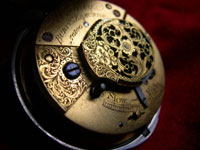 |
William Ray, Bury St Edmunds, 1830-1864 There were a number of clockmaking Rays associated with Sudbury, including two Williams, but Haggar and Miller thought that our William was not related to them. We now know from a descendent that they were, in fact, related. See below under David Ray. William Ray married Elizabeth Arbon of Bury on 20th March 1830. Directories record him at 2 Brentgovel Street in 1830, 1839, 1844, 1846, 1855 and 1864. The shop was still in business in 1884. William Ray is known from his painted dial Long Case clocks. In 2010 a pocket watch with his name engraved on it was up for sale on EBay for £350. The description was as follows:
"This is a Silver pair case pocket watch by William Ray of Bury St Edmunds (1830--1879), Suffolk . This pocket watch is working well.
|
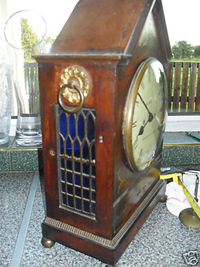 |
David Ray, Bury St Edmunds and Brandon, 1844-1846 David Ray was in the 1844 Directory at 25 Hatter Street. In the same Directory he was also found at Brandon High Street. In 1846 he was listed at Brandon only. He is known in the literature from a few painted dial Long Case clocks. However, this bracket clock appeared on Ebay in September, 2008. Click on the picture to see the dial in close-up. There were also a number of clockmaker Rays associated with Sudbury, but Haggar and Miller stated that it is not known if David Ray was related to them.
In 2015 I was contacted by a descendent who had researched the family history. "William Ray and David Ray's eldest sister Sarah was my 4x Great Grandmother, hence we've been following the family sidelines forward."
My correspondent, Nicola P, tells me that "For information, William Ray of Bury St Edmunds (1830-1864) and David Ray of Bury St Edmunds and Brandon (1844-1846) were brothers, both born at Lavenham and were grandsons of William Ray the clockmaker of Sudbury. Their father was William's son, Abraham Ray, who was a carpenter/sawyer/builder at Lavenham, who was therefore not following in his father's footsteps.
Dollar Tollady, Bury St Edmunds, 1844-1864, and Alfred Tolladay, 1865-1891 Remarkable mainly for his Dickensian name, Dollar Tollady worked at 3 Northgate Street in the 1844 and 1846 Directories. The 1844 Directory actually had him as Dullar Tollady. In 1855 and 1864, he was recorded at 118 Northgate Street.
|
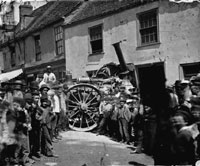 |
An Alfred Edward Tolladay was recorded in later Directories from 1865 to 1891. In 1865 he was located at 118 Northgate Street, and by 1891 he was at 11 Hatter Street. Tolladay's is also remembered because of a notable traction engine crash. This picture is from the Spanton-Jarman Collection at Bury St Edmunds Record Office. The glass negative of approximately 305mm x 254mm, was produced by a wet plate process so was probably made sometime between 1870 and 1890. A runaway steam engine has crashed into this row of houses in Northgate Street. The accident attracted quite a crowd, and the photographer himself must have been quite a novelty too. The premises behind the engine belonged to Alfred Edward Tollady, this building was his beer house at 117. White's 1874 Directory lists him as a 'watch and clock maker, jeweller, glass and china riveter, umbrella maker and lamp dealer', at number 118 Northgate Street.
George Carter, Cavendish, 1844-1874
A long case clock with a painted dial is recorded for this maker. His name is in the directories covering this period.
Henry Clarke, Bury St Edmunds, 1855-1864 Henry Clarke was recorded in the 1864 Directory as a 'Watchmaker and Hairdresser', at 2 Southgate Street, Bury St Edmunds. Haggar and Millar report that he was in business as a watch and clock maker in 1855.
Frederick Taylor, Haverhill, 1855-1864 Taylor was recorded in the Directories for 1855 and 1864. He is known for a painted dial Long Case clock, signed, "Taylor, Haverhill".
John Buxton, Wickhambrook, 1864 John Buxton was recorded in the 1864 Directory. A 30 hour long case clock is known signed "J Buxton Wickhambrook." It has a painted dial with a design of a swan and hour glass.
R J Rive, Ixworth, 19th century An oak 8-day semi-regulator Long Case clock has been reported for this otherwise unknown maker. It was noted in Haggar and Miller's Supplement as follows: "Anchor escapement, maintaining power, timepiece movement with square plates, painted round dial, matching 'Breguet' pattern hands."
|
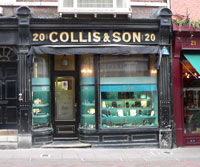 |
William Humphrey Collis, Bury St Edmunds, 1864-1885 This is the founder of the well known jewellers' shop Collis & Son at 20 Abbeygate Street. Directories record him there from 1864 to 1885. By 1891 he had set up as W H Collis and Son in Cornhill, Ipswich, but the Abbeygate shop retains the name Collis & Son up to the present time. |
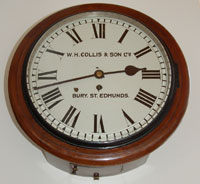 |
The illustrated clock was sold by Collis and Son, but at this time the whole clock was probably bought in for re-sale. The retailer's name may have been added at the factory to order.
|
"Time Measurement Instruments- catalogue of the John Gershom Parkington Memorial Collection" 3rd edition of 1979
'Suffolk Clocks & Clockmakers' by Arthur Haggar and Leonard Miller 1974
'Supplement to Suffolk Clocks and Clockmakers' by Haggar and Miller, 1979
Advice and information from Peter Webb, of Ernest Webb, Jewellers of 4, Risbygate Street, BSE (established 1952)
The superb horological website of Clock Dealer Brian Loomes at www.brianloomes.com
Clock Dealer Richard Harris at www.rchclocks.fsnet.co.uk
The website of Leigh Extence at www.extence.co.uk
Information prepared by David Addy, 27th April 2006
| Go to Clocks Homepage | Last updated 12th March 2018 | Go to Home Page |